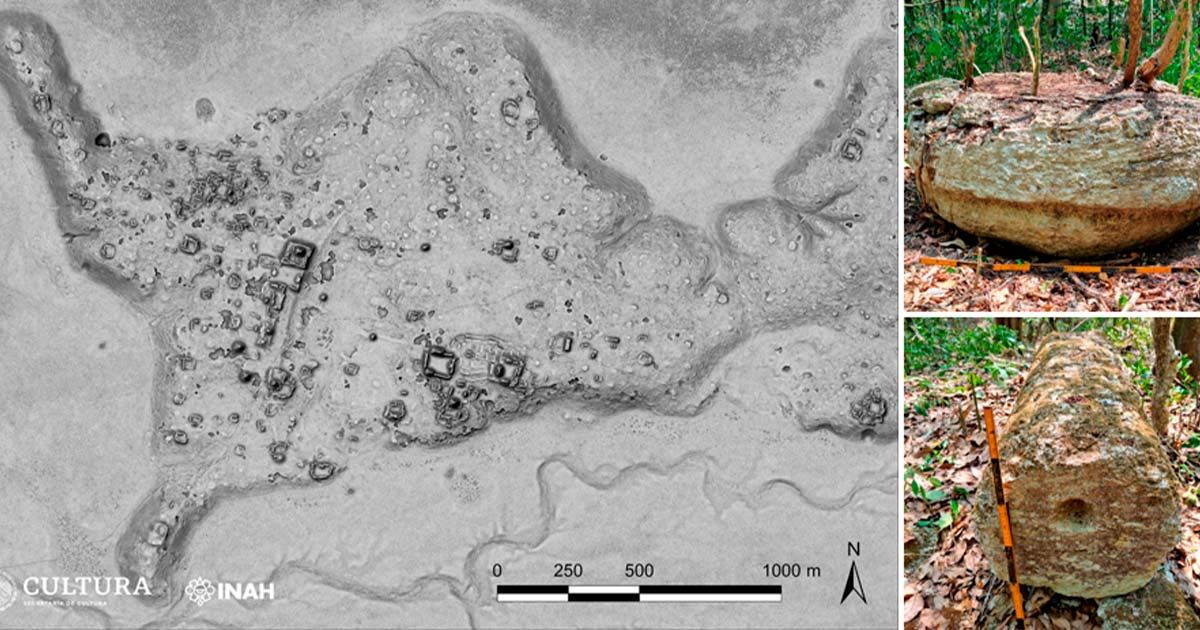Huge Lost Maya City Has Emerged From the Jungle in Mexico
Mexican archaeologists harnessed the potential of LiDAR drones to undertake an extensive survey of the Yucatan Peninsula, yielding the remarkable discovery of a once-forgotten city. This extraordinary find includes pyramids, a ball court and sacred spaces distinguished by the presence of meticulously crafted stone columns.
Mexico’s National Institute for Anthropology and History ( INAH) has just announced that a team of archaeologists have identified a jungle-locked, ancient Maya city. Discovered deep in southern Mexico, the previously unknown city comprises large pyramids, stone columns, three plazas with “imposing buildings” and other sacred stone structures arranged in concentric circles.
INAH said the city is located in the state of Campeche, in the Balamku Ecological Reserve on the country's Yucatan Peninsula . Archaeologists have named this lost Maya city in Mexico Ocomtun, which in the Yucatec Maya language means “stone column.” Speculatively, INAH said the city would have been an important Maya center for the entirety of the peninsula's central lowland region, between 250 and 1000 AD.
A stone altar discovered at the site of the lost Maya city in Mexico. (Ivan Ṡprajc / INAH)
High Living at Lost Maya City in Mexico
Reuters reported that lead archaeologist Ivan Sprajc said the lost Maya city was discovered during a March LiDAR exploration of a largely uncharted stretch of jungle in the Balamku Ecological Reserve, in Mexico's Yucatan Peninsula . Boasting breathtaking biodiversity, this region preserves delicate ecosystems, including rich forests, deep cenotes and expansive wetlands.
Sprajc described the search zone as being “larger than Luxembourg,” so that’s about 2,586 square kilometers (998.67 square miles), or over 400,000 hectares. The Ocomtun site, like most other Maya settlements, is located on high ground overlooking extensive wetlands.
Archaeologists have located several buildings at the site of the lost Maya city now known as Ocomtun in Mexico, such as this one with stone steps leading to its entrance. (Ivan Ṡprajc / INAH)
A Fully Functional, and Ritualized, Maya City
Ocomtun was once equipped with 15-meter (49.21 ft) high pyramidal structures and a ball court , for the playing of Pre-Hispanic ball games. Combining elements of sport, ritual and religious significance, this sport was played by ancient civilizations such as the Maya and Aztecs.
Players used only their hips to propel a rubber ball through stone hoops, representing cosmic battles and fertility rites. So culturally important was this game that it was central in mythology and served as a way of offering the gods human sacrifices.
A series of central altars were discovered closer to the La Rigueña river, which INAH said “may have been designed for community rituals.” In a report by BBC, Ivan Sprajc explained that the cylindrical stone columns, which prompted the researchers to name the site Ocomtún, “were probably entrances to rooms in the upper parts of the buildings.” According to Sprajc, the city appears to have been significantly rebuilt between 800 and 1000 AD.
Due to the many stone columns discovered at the lost Maya city in Mexico, archaeologists have named the site Ocomtún, which means “stone column” in the ancient Maya language. (Ivan Ṡprajc / INAH)
A City on the Edge of Life Itself
The La Rigueña River flows through the scenic landscapes of the area. Stretching across approximately 110 kilometers (68.35 miles), the river winds its way through lush forests, agricultural fields and picturesque towns. In Maya times, the river held significant cultural and practical importance, for it provided a vital source of freshwater for Maya communities, supporting agriculture, fishing and transportation.
An engraved stone discovered within the Balamku Ecological Reserve at the site of the lost Maya city in Mexico which archaeologists have named Ocomtún. (Ivan Ṡprajc / INAH)
No less important were the river's banks, which witnessed bustling trade routes, with people using canoes to navigate its waters and exchange goods. In every way, this river was a lifeline connecting surrounding communities with the main city and sustaining their daily lives. Evidence suggests the lost Maya city entered a period of decline around 800 to 1000 AD, at which time the Lowland Maya civilization collapsed.
The collapse of the Lowland Maya civilization in the 10th century is a subject of debate, and archaeologists point to different factors, such as environmental degradation, political unrest, warfare and the decline of trade networks. It is most probable that all of these factors contributed to the collapse of the recently discovered Maya city in Mexico, but perhaps future excavations at Ocomtún will help answer this historical mystery.
Top image: LiDAR technology has helped archaeologists identify a lost Maya city in Mexico. Source: Ivan Ṡprajc / INAH
By Ashley Cowie
Source: Ancient Origins


